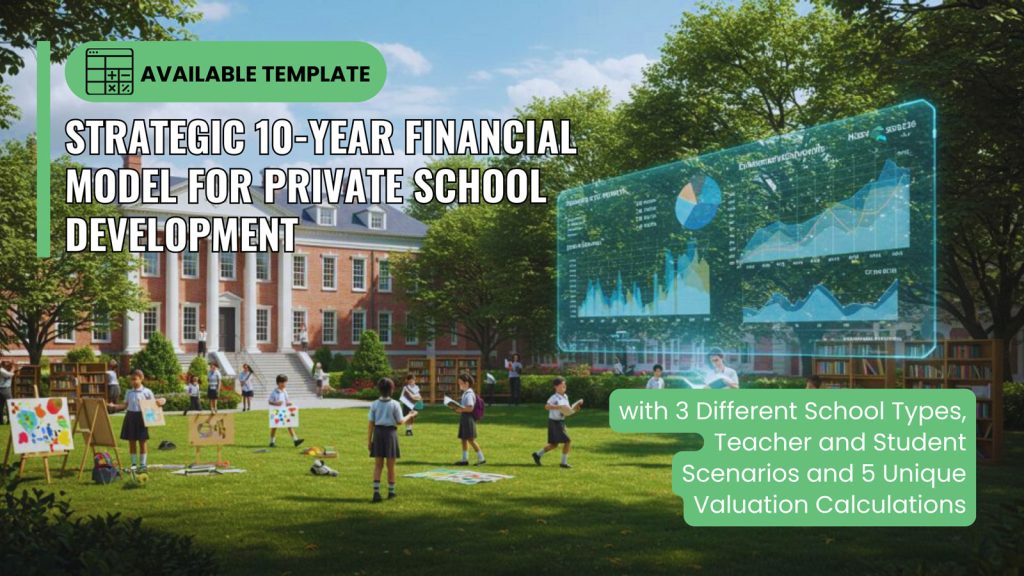
The 10-Year Private School Financial Model Excel Template is a comprehensive tool for education entrepreneurs, school owners and investors who require accurate financial forecasting and valuation over a 10-year horizon. It transforms school strategy into linked financial statements that quantify enrolment, tuition, staffing, CAPEX and funding.
The model features enrolment drivers for each grade or campus, tuition and boarding fee inputs, operating cost categories (salaries, maintenance, transport, utilities) and a capital schedule for construction or expansion. All tabs flow to a three-statement output (income, balance sheet, cash flow).
Scenario switches let users test enrolment growth and fee changes. The built-in DCF valuation calculates NPV and IRR to assess project returns under varied financing structures. Dashboard charts summarise KPIs: revenue per student, retention rate, EBITDA margin, and payback period.
Used by schools across Africa, the UK and Asia, this model adheres to best-practice modelling standards with colour-coded inputs and clear audit trails. The school financial model provides the ideal foundation for fundraising decks, bank loans and board approvals, offering clarity, credibility and control for every education project.
| Component | Description |
| Full Transparency and Editability | This private school startup model accommodates different education levels, allowing adjustments for student intake, tuition fees, teacher salaries, and operational expenses based on institution type. |
| Student Enrolment and Retention | Tracks student intake, withdrawals, retention rates, and year-end student population, ensuring accurate forecasting. |
| Staffing and Payroll Calculations | Automatically calculates the number of teachers, assistants, and administrative staff required based on student-to-teacher ratios. Includes salary structures, performance bonuses, medical aid, and tax deductions (PAYE, UIF, etc.). |
| Revenue Streams | Captures tuition fees, enrolment deposits, administration fees, extracurricular activities, meal plans, and IT infrastructure requirements. |
| CAPEX and Infrastructure Investments | Forecasts school-specific capital expenditures, including building costs, classroom equipment, technology, sports facilities, and transportation assets. |
| No Advanced Knowledge Required | Designed for non-technical users. Input fields are clearly marked. |
| Debt and Equity Funding | Support for funding via grants, loans, VC, or internal equity — includes repayment and IRR logic. |
| Scenario Testing Capabilities | Simulate growth, fee changes, or cost escalations to assess feasibility and investor outcomes. |
| Valuation and IRR Tools | Includes NPV, IRR, and valuation metrics with visual timelines and profitability analysis. |
| Dashboard and Visual Analytics | An interactive dashboard provides real-time graphs, financial trends, and key performance indicators (KPIs). |
| Pre-Populated Mock Scenario | The model comes with a pre-filled sample school financial projection, making it easy to understand and apply. |
| Editable and User-Friendly Design | No advanced Excel knowledge required – All complex formulas are pre-programmed, with intuitive input fields and guided instructions. |
The use of this financial model is solely at the user’s own risk. Best Financial Models provides the template as a tool to assist users in their business planning and decision-making processes. However, the responsibility for adhering to the model’s instructions and guidelines lies entirely with the user. Best Financial Models cannot and will not be held liable for any inaccuracies, errors, or unintended outcomes resulting from the user deviating from the prescribed usage, including but not limited to the deletion, addition, or modification of rows, columns, formulas, or any other components of the model. Users are strongly advised to exercise caution when making any changes to the model to ensure its integrity and reliability are maintained.
| Business Type | Private School |
|---|---|
| File Format | Microsoft Excel |
A private school financial model Excel is a structured tool that turns an educational concept into a quantified, 10-year forecast. It links enrolment growth, tuition fees, staffing costs, and CAPEX into automated financial statements and valuation outputs. In this Best Financial Models template, every assumption—student numbers, teacher-to-pupil ratios, construction timelines, or debt structure—feeds directly into a DCF valuation and IRR analysis.
This allows founders and investors to see when the project becomes profitable and how capital will be repaid. By replacing guesswork with transparent data, the model demonstrates financial feasibility and builds confidence among banks, donors, and private equity funders. It’s the foundation for credible decision-making in any education venture.
The school financial model Excel produces lender-ready projections that clearly show cash inflows, operating costs, and debt-service coverage (DSCR). Its 10-year forecast includes automated loan-amortisation schedules and sensitivity tests for enrolment, fee growth, and inflation. Investors rely on its valuation tab to assess equity returns under multiple capital structures.
By quantifying risk and illustrating upside potential, the model bridges the gap between educational vision and financial reality. When included in a school business plan, it signals professionalism and transparency—key traits funders use to evaluate creditworthiness. Whether for bank finance, PPP arrangements, or private capital, this financial model for education transforms narratives into verifiable numbers.
Yes. The education financial model Excel template supports up to three grade groups or curriculum streams within one unified workbook. Each sheet tracks student intake, fee structures, staffing costs, and operating expenses independently. A consolidated dashboard then merges the results to present total revenue, EBITDA, and cash flow across the entire institution.
Users can model pre-school, primary school, and high school side-by-side and instantly see how each affects profitability and valuation. A critical part of a school business plan or education business plan, this flexibility helps school groups plan phased expansion or acquisitions while maintaining audit-ready transparency. For investors, it clarifies which campuses generate the highest returns and how diversification across curricula stabilises long-term performance.
This private school financial model Excel template tracks all major KPIs used in the education sector—revenue per student, retention rate, cost per teacher, EBITDA margin, and DSCR. It automatically generates 10-year income, balance sheet, and cash flow statements, and computes valuation metrics such as NPV, IRR, payback period, and equity value.
Dashboards visualise results through dynamic charts for enrolment trends, fee growth, and funding requirements. Because every driver is connected, adjustments to tuition fees or staffing are instantly reflected in all ratios. This level of visibility gives investors confidence that the model demonstrates operational reality, not assumptions. It is both a management control system and a valuation engine for private school projects.
The school financial projections Excel template uses grade-level intake and retention assumptions to calculate total enrolment each year. Tuition and boarding fees are set per student, with optional extras for uniforms, transport, and catering. The model multiplies these by projected numbers to produce monthly and annual revenue. Growth can be varied by grade type, allowing a realistic ramp-up after construction or marketing campaigns.
Linked dashboards show revenue mix, fee per student, and occupancy rate, while the income statement updates automatically. This granular forecasting approach helps schools identify pricing opportunities and funding gaps early, improving strategic planning and investor communication.
Absolutely. Existing operators can use the education financial model Excel file to generate forward-looking 10-year projections based on their historical financials. The model incorporates refurbishment CAPEX, rebranding costs, and incremental staffing changes, allowing management to compare “as-is” versus “expansion” scenarios.
Its valuation tab quantifies the uplift in enterprise value, while loan schedules test different refinancing options. For boards and investors, this demonstrates value creation over time and the school’s capacity to service new debt. By offering transparent forecasts and key ratios such as DSCR and IRR, the model becomes an indispensable tool for negotiations with banks and potential acquirers.
All input cells are clearly colour-coded and allow changes to enrolment growth, tuition fees, staffing ratios, and CAPEX to be illustrated, showing how financial results respond to these changes. The private school financial model Excel recalculates every linked statement and valuation metric—providing clear visual comparisons on cash flow, debt coverage, and ROI. This allows decision-makers to gauge risk tolerance, optimise pricing, and plan contingencies. Such transparency turns board discussions from speculation into data-driven strategy.
Unlike generic spreadsheets, this school financial projection model is purpose-built for private education. It includes sector-specific drivers—student enrolment by grade, boarding versus day ratios, academic calendar timing, and seasonal expenses. The file uses colour-coded inputs, consistent formulas, and a clean audit trail that meets international modelling standards.
It also integrates valuation logic (DCF & IRR), debt service modules, and automated dashboards, providing both financial control and investor-grade presentation. Its structure supports schools from early feasibility through maturity, helping founders, consultants, and financiers make reliable, comparable assessments of project performance.
The private school financial model Excel contains a dedicated HR planning tab where users define staff types—teachers, administrators, and support staff—alongside salary bands and annual increments. These feed into the operating expense schedule and cash-flow forecast, ensuring that payroll remains aligned with enrolment growth and fee income.
Managers can test hiring plans or retrenchment scenarios and instantly see margin effects. The dashboard summarises cost per student and staff efficiency ratios, vital for sustainable expansion. By linking human resources to revenue drivers, the model enables schools to balance quality education with financial discipline and long-term profitability.
For founders, it delivers clarity; for investors, credibility; and for banks, confidence. This financial education model Excel template consolidates every aspect of school finance—revenues, expenses, capital costs, and returns—into a single transparent system. Stakeholders can review audited assumptions, monitor performance, and adjust parameters as the school evolves.
The result is a single source of truth for feasibility studies, education business plans, or valuations. By aligning educational impact with measurable financial outcomes, you support responsible growth and position your project as a professional, data-driven investment opportunity in the global private education market.
Plan, fund, and grow your private school with confidence.
This structured 10-Year Private School Financial Model Excel Template is perfect for private schools. It covers enrolment, tuition revenue, staffing, CAPEX and DCF valuation.
This school financial model features enrolment drivers for each grade, tuition and boarding fee inputs, operating cost categories (salaries, maintenance, transport, utilities) and a capital schedule for construction or expansion. All tabs flow to a three-statement output (income, balance sheet, cash flow).
This school financial model Excel produces lender-ready projections that clearly show cash inflows, operating costs, and debt-service coverage (DSCR). Its 10-year forecast includes automated loan-amortisation schedules, fee growth, and inflation.
By replacing guesswork with transparent data, the model demonstrates financial feasibility and builds confidence among banks, donors, and private equity funders. It’s the foundation for credible decision-making in any education venture.
R2,499.00
We accept various methods of payment, including Visa, Mastercard, and EFT.
Our site is secured with SSL certification and we do not store any of your payment details.
Immediate access to your chosen financial model, compatible with Excel or Google Sheets.
Our templates are designed for global use, featuring support for all major currencies.
Utilise this investment-grade School Financial Model Excel template in conjunction with our custom Education Business Plan and Feasibility Study services at JTB Consulting to enhance your funding proposal and establish investor trust.
We don’t spam, and you can always opt out at any time.
